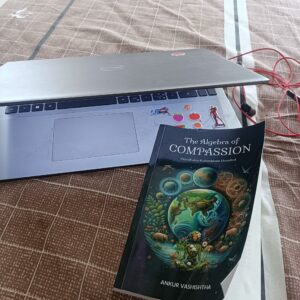Introduction
Ankur Vasishtha’s The Algebra of Compassion presents a thought-provoking exploration of the intersections between mathematics and human emotion. Centering around the ancient Indian concept of Vasudhaiva Kutumbakam—the idea that the world is one family. This unique work melds memoir, philosophy, and social commentary. The book invite readers into a deeper understanding of compassion. On the other hand it challenges the modern tendency to reduce human experiences to mere data points. It is a nonfiction told through stories and fables making it an enjoyable read. Blending fables and mathematical model has been the highlight of this reading experience.
Overview
The book posits that compassion, much like algebra, can be dissected, understood, and even quantified. In a clever manner the author analyses the life experiences of Miran, Amari, Lian and Yuna to explore different ideologies like capitalism, socialism, and communism, reveal how these economic systems interact with human motivations and societal impacts. Vasishtha uses mathematical concepts as metaphors to illustrate the complexity of human relationships and societal structures. By doing so, he not only bridges the gap between abstract thought and personal experience but also emphasizes the importance of empathy in our increasingly quantitative world.

Themes
- The Interplay of Math and Emotion -Vasishtha demonstrates how mathematical principles can mirror human interactions. For instance, he explores the idea of variables in equations as representations of individual emotions and circumstances, urging readers to see the nuances in human relationships. As a reader I found the perspective extremely fresh perspective. Quantifying passion and emotion has never been an easy task.
- Critique of Quantification – Taking a cue from the previous theme, the next idea the book is the critique of society’s obsession with metrics. Vasishtha highlights how this focus often leads to a neglect of the very emotions that make us human. His argument in fields like healthcare and education, reducing individuals to numbers can erode the empathy that should guide these sectors. This insightful observation should serve as a reminder to review our priorities.
- Cultivating Compassion – Vasishtha emphasizes that compassion is not merely an innate quality but a skill that requires nurturing. He offers practical insights into how individuals can cultivate empathy in their daily lives. Through personal anecdotes and broader societal examples, he illustrates that small acts of kindness can create significant ripples of change.
What works for me
The beautiful cover is the first thing that one would be fascinated with, it complements perfectly the unique take of the book.
Another standout strengths of *The Algebra of Compassion* is its innovative approach to a commonly overlooked subject of emotion, passion and compassion. Vasishtha’s fusion of math and emotion invites readers to think critically about their relationships and societal dynamics.
Vasishtha’s prose is engaging and accessible, making complex mathematical ideas digestible for a general audience. He adeptly balances theoretical concepts with personal stories, creating a narrative that resonates on multiple levels. His ability to intertwine philosophical insights from various disciplines enriches the reading experience, allowing for a comprehensive exploration of the book’s central themes.
However, at times, the transitions between mathematical theory and personal narrative can feel slightly abrupt, potentially leaving some readers wanting a smoother integration of ideas.
Conclusion
The Algebra of Compassion is a compelling and enlightening read that encourages a reevaluation of how we perceive and practice compassion in a data-driven world. Ankur Vasishtha throws an open question us to recognize that empathy is not just a soft skill but a fundamental component of a thriving society. The whole theme makes the book a valuable addition to contemporary discussions on compassion and connectivity. You can get the book here.

